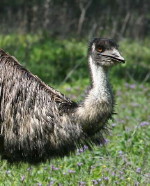- «Fences Intro |
- «Fences 1 |
- «Fences 2 |
- «Fences 3 |
- «Fences 4 |
- 5 Electric Fences
5 Electric Fences
High-tensile wire is vulnerable to fire, and (if barbed) a risk for cranes. So if wetlands must be fenced, a solution could be electric fencing, potentially solar-powered. An electric strand can also greatly increase effectiveness of pig exclusion fencing (external site, pdf 1.05MB). But vegetation management – essential for electric fences and cranes – can be a serious business cost in the tropics.

↑ Solar-powered electric fence near Carnarvon, WA. The controller is in the old fridge (R Gray)
↓ Farm wetland protected by 6 strand plain HT wire + 1 live wire, with timber rails at cattle water access (SE Victoria, cranesnorth)

The Kimberley design
Here with grateful thanks to a WA correspondent, are specs for the ‘Kimberley steel and porcelain low-level fire-resistant electric fence’ – no barb, and with the bottom wire at 52.5 cm, young Brolgas and Sarus Cranes should be able to walk under the fence for at least their first month.
- 3-line 2.5mm HTHG plain wire (top and bottom – and centre +). Having the top wire reduces damage from lightning strike
- Bottom wire @ 52.5 cms, centre @ 81.0 cms and top @ 113.5 cms above ground level
- Wire strained to 2 kN (450 lbs). Good strainer assemblies essential but only employed at ends of fence or where fence changes direction
- Steel pickets @ 40 metre spacings
- 2 x 63.5 cms Waratah steel droppers per panel
- Insulation on both posts and droppers by 32 mm porcelain cotton reel insulators
- Energiser placed at mid-point on the fence. Good earthing essential.
- Attention to detail in construction important to minimise maintenance requirements
- If kangaroo or emu activity likely to be significant, suggest instead of droppers bring the post interval in to 15 metres
- Kangaroos easily negotiate this fence design by going underneath, no contact with + wire
- Can supply insulator attachment methods (posts/droppers) if required
Feedback
Comments and suggestions on Crane-friendly Fencing are welcome, contact details here». Feedback is especially welcome from landowners who have tried varied styles of electric fencing combined with vegetation management around or near wetlands, dams or swamps.
Do please read the Disclaimer page carefully before applying ideas or advice from this site. And to discover why wetland fencing – including fencing promoted for environmental reasons – can create problems for cranes and other large waterbirds, see Fencing Intro and Fences 1: Issues and Risks. Fences 2: Decision Guide gives checklists that factor cranes and other large waterbirds into wetland fencing decisions.
Next: 6 | Fencing downloads and links»




